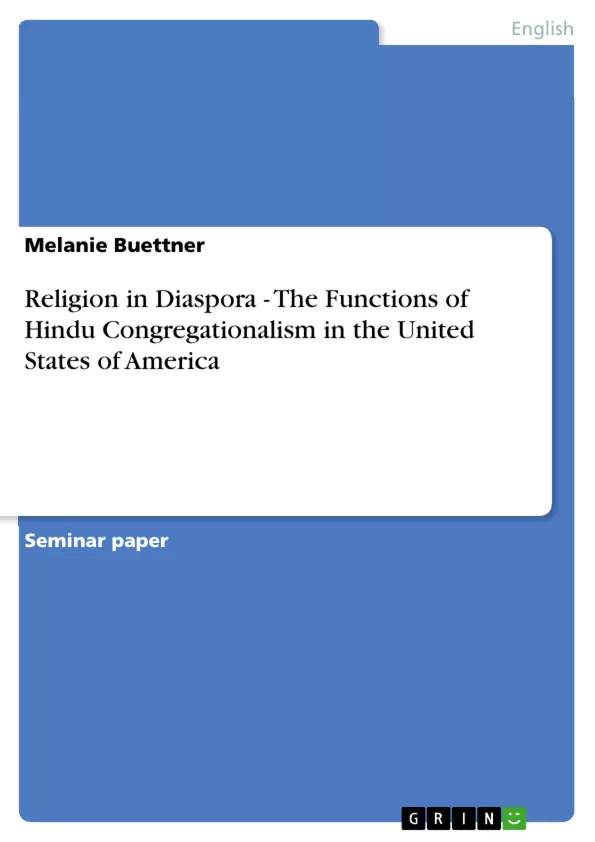In her book A Place at the Multicultural Table: The Development of an American Hinduism Prema Kurien states that
“Hinduism has taken different forms in the countries where it has been transplanted, depending on the interaction between the social and cultural characteristics of the particular group of immigrants and the characteristics of the receiving society.”
Only recently, starting in the early-1990s, has the paramount importance of immigrant religion in the host country been acknowledged by scholars in the field of Diaspora Studies. In terms of the Hindu Diaspora of the United States, research conducted by Diana L. Eck, Pyong Gap Min and Prema Kurien has been groundbreaking. Why and how has Hinduism changed in the American setting? In the U.S. organizations of Popular Hinduism have been created that do not exist in India. These include for example Hindu student organizations, local worship and singing groups (satsangs), as well as educational groups for children (bala vihars). Practices in Hindu Temples built in the U.S. have also undergone some modifications when compared with traditional Hindu temples in India.
What are the functions of those local associations and the new practices in Hindu Temples? Were they perhaps founded to build an ethnic community and to preserve Indian traditions and culture in a foreign environment? Are they a means to resist assimilation into the American host country society? Or does Hinduism, quite to the contrary, serve as a vehicle for actually becoming American?
To resolve all those questions outlined above I am going to analyze select organizations of Popular Hinduism in the U.S., starting with an examination of the local worship and children educational groups. Then I will turn to the discussion of the possible functions of the new practices in Hindu temples in the United States. I will end my paper with a short summary of my findings.
Inhaltsverzeichnis (Table of Contents)
- Introduction
- Organizations of Popular Hinduism in the American Diaspora
- Local worship groups (satsangs)
- Educational groups for children and teenagers (bala vihars)
- Hindu Temples in the United States of America
- Conclusion
Zielsetzung und Themenschwerpunkte (Objectives and Key Themes)
This paper analyzes the functions of Hindu congregationalism in the United States of America, focusing on how Hinduism has adapted to the American setting and the role of local associations and new practices in Hindu temples. The paper examines the motivations behind these developments, considering whether they serve to build an ethnic community, preserve Indian traditions, resist assimilation, or facilitate Americanization.- The changing face of Hinduism in the American Diaspora.
- The development of congregationalism in American Hinduism.
- The functions of local worship groups (satsangs) and educational groups (bala vihars).
- The role of Hindu temples in the United States.
- The relationship between Hinduism and American identity.
Zusammenfassung der Kapitel (Chapter Summaries)
Introduction
The introduction highlights the evolving nature of Hinduism in diasporic contexts, emphasizing the unique forms it takes based on the interaction between immigrant communities and their host societies. The introduction also acknowledges the growing recognition of immigrant religion in diaspora studies and highlights the groundbreaking work of scholars like Diana L. Eck, Pyong Gap Min, and Prema Kurien in understanding the Hindu Diaspora in the United States.Organizations of Popular Hinduism in the American Diaspora
This chapter delves into the concept of "Popular Hinduism," a term coined by Steven Vertovec and adopted by Prema Kurien to distinguish it from "Official Hinduism," which represents the articulation of Hinduism by leaders of organizations claiming to speak for all Hindus. The chapter then introduces the concept of "Congregationalism" in American Hinduism, noting its uniqueness compared to traditional Indian Hinduism.Local worship groups (satsangs)
This section focuses on "satsangs," local Hindu worship groups typically meeting monthly or more frequently in member families' homes. The section examines the shared cultural and linguistic backgrounds of satsang members, often stemming from the same regions of India, illustrated by examples like the Organization of Hindu Malayees (OHM), founded by and primarily consisting of Hindu immigrants from Kerala. The chapter also outlines the typical structure of a satsang meeting, which includes a pooja (worship) involving prayers, chants, devotional songs (bhajan), and discussions of sacred literature. The chapter concludes by exploring the possible motivations for Hindus in the American Diaspora to participate in satsangs, connecting it to the historical importance of religion and ethnicity in constructing identity in the United States.Schlüsselwörter (Keywords)
This paper explores the themes of Hinduism in the American Diaspora, Popular Hinduism, Congregationalism, local worship groups (satsangs), educational groups (bala vihars), Hindu Temples in the United States, and the relationship between Hinduism and American identity.- Arbeit zitieren
- Melanie Buettner (Autor:in), 2010, Religion in Diaspora - The Functions of Hindu Congregationalism in the United States of America, München, GRIN Verlag, https://www.grin.com/document/150980



